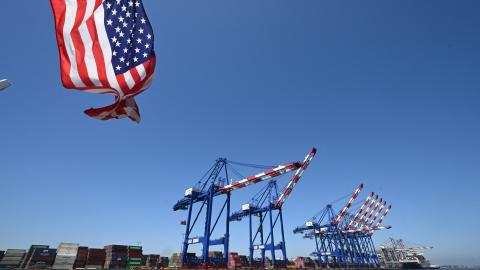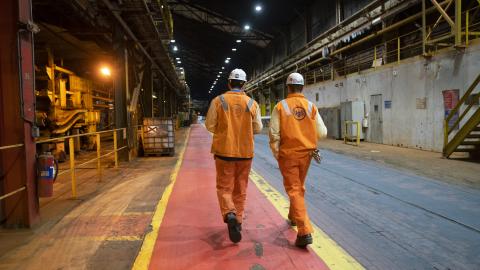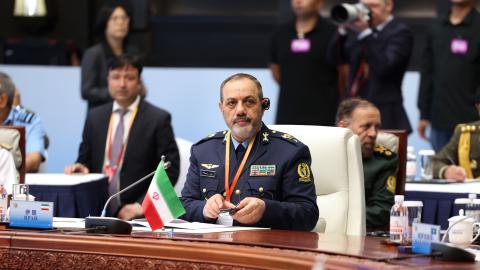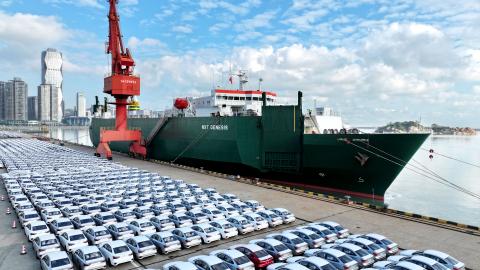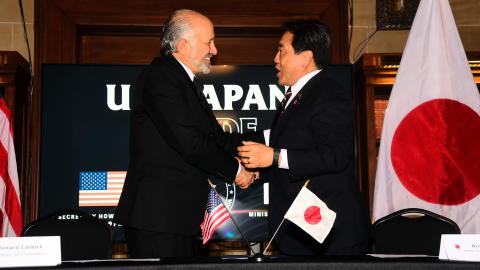p(firstLetter). On April 18 and 19, China conducted live-fire exercises in the Taiwan Strait. Force dispositions of the People’s Liberation Army did not indicate a potential invasion attempt: The naval portion of the drills was slated to occur within Chinese territorial waters. However, the subsequent aerial exercises were markedly more provocative. A fleet of PLA Air Force assets, including the Y-8 medium-range transport and patrol aircraft, the H-6 strategic bomber, and the Tu-154 electronic surveillance aircraft, all escorted by Su-30 and J-11 fighters, entered Taiwan’s Air Defense Identification Zone, ignoring Taiwan’s repeated warnings to depart. Zhai Peisong, an H-6K commander who participated in the exercise, justified the action by stating that Taiwan is “in the bosom of the motherland” and that the PLAAF has a “sacred mission” to defend the motherland’s territory.
Over the past month, China has deployed the aircraft carrier Liaoning on what has functionally been a circumnavigation of Taiwan’s territorial waters. The Liaoning, along with escorting surface combatants, transited the Taiwan Strait on March 21, heading south to participate in a naval exercise of more than 40 vessels in the South China Sea. The Liaoning then returned north, passing Taiwan’s eastern side en route to live fire exercises in the East China Sea. To underscore the attempted intimidation, the carrier returned in April, sailing near Taiwan’s east coast.
The South and East China Seas are the two most visible zones of contest between China and its regional and international rivals. China competes with the Philippines, Vietnam, and Taiwan in the South China Sea. A large measure of the competition is jockeying for control over a nest of islands and tropical reefs that provide access to natural resources on the sea floor and enable greater control of the shipping routes over which energy is transported from the Near East to China and Japan. A similar situation exists in the East China Sea, with Japan and, to a lesser extent, South Korea serving as mainland China’s opponents.
The Taiwan issue has been persistent since 1949, when the Communists drove the nationalist Kuomintang off the mainland and established the People’s Republic of China. There are several reasons for the enduring significance of Taiwan in China’s strategic calculus. Legitimacy plays a clear role. The existence of a free, prosperous, and democratic Taiwan threatens to expose as farcical the Chinese Communist Party’s assertions of ideological superiority over Western liberalism. If Taiwan were to declare its independence, China would likely respond violently: A legally independent Taiwan would undermine Beijing’s claims to sovereignty over “greater China” and could lead toward further internal fracturing.
Strategic interest, however, is the most apparent element of China’s Taiwan policy. Taiwan is the linchpin of the “first island chain,” a string of insular locations that runs from the Kamchatka Peninsula, in the Russian Far East, through Japan, Taiwan, and the northern Philippines, to the Malay Peninsula in the south. The first island chain bounds the South and East China Seas, both of which are critical bodies of international water through which energy supplies and trade goods flow into and out of China and Japan. The PRC has confronted this island-chain quandary since it first took power.
Control of the South and East China Seas would allow the PRC to extract its rich resources and stop a foreign power from choking off resource and trade flows to the mainland — although no foreign power has indicated an interest in doing so. A Chinese-controlled first island chain, by contrast, would serve as a springboard for future expansion by providing the PLA with an uncontested operational bastion from which it could strike against its enemies, without fear of reprisals against the Chinese mainland or the denial of trade and energy flows to the PRC.
The role of maritime trade cannot be overemphasized. China’s economy relies on unmatched volumes of material and energy imports. Even small interruptions in this system could trigger cascading failures that break the material social contract that the Communist Party maintains with the Chinese people, converting passive working and middle-class urban citizens into Tiananmen-style protesters overnight. Names not generally discussed in Western media outlets — especially Kunming, Harbin, Fuzhou, Jinan, and other “tier II” cities that receive lower levels of infrastructure development funding — could explode with unrest. If mishandled, such internal issues could threaten the survival of the Chinese Communist system and its leadership. Controlling the first island chain is vital to the Chinese Communist Party’s interest.
Taiwan is the center of the first island chain. Military assets based in the Philippines, Japan, and Vietnam can pressure Chinese forces in the South and East China Seas. But Taiwan functionally acts as a massive aircraft carrier and expeditionary military base, permanently afloat 110 miles off the Chinese coastline, with the positioning to interdict and disrupt Chinese military forces in both the East and South China Seas. China cannot control the first island chain so long as Taiwan remains independent.
A direct armed confrontation over the Taiwan Strait is no certain proposition for China, at least not today. Taiwan’s military would not be able to defeat the PLA independently, but its high-quality armed services would make neutralizing Taiwan a high-cost operation. Moreover, the U.S. and Japan would likely come to Taiwan’s aid during a conflict, threatening to transform a localized confrontation into a general Pacific war involving two nuclear-armed powers, with unknowable and probably dire consequences.
The threat of long-term general war may deter direct armed attack but cannot by itself prevent an incrementalist strategy that gradually erodes Taiwan’s sovereignty, isolates it from the international community, and erodes the ability of the U.S. (and Japan) to intervene in a cross-Strait conflict. So it would be folly to discount the effect of China’s sustained campaign to limit Taiwan’s international recognition.
In the past twelve months, China has successfully enticed Panama and the Dominican Republic to end their diplomatic recognition of Taiwan. China’s tactics are straightforward: bribery. Beijing has promised the leadership in Panama City and Santo Domingo significant long-term investment as reward for compliance with Chinese wishes. Today, only 19 states recognize Taiwan, a number that could decrease as the “People’s Republic” leverages growing economic links with Latin America and the Caribbean. One can envision a scenario in which the U.S. and Japan come to the defense of a state that lacks recognition from all but a fraction of the international community and that they themselves do not even recognize.
Other subtle steps are similarly worrying. The PLAAF recently released a propaganda film in Hokkien, the dialect of Chinese spoken in Taiwan. The film boasts of the power of the “war god” H-6K strategic bomber, an aircraft explicitly designed to carry long-range anti-ship missiles that can attack American aircraft carriers from stand-off positions. Combined with China’s other land- and sea-based long-range missile systems, the H-6K helps create a potent barrier for U.S. and allied forces in any conflict within the first island chain.
The Chinese government has also increased the air traffic over the Taiwan Strait by opening a new major air route, M503, that passes just over four and a half miles from the “middle line,” the air and maritime border demarcating Chinese and Taiwanese territory. Traveling from mainland China to Taiwan requires boarding flights at airports in certain designated cities: Hong Kong, Shanghai, or Shijiazhuang. China claims that the M503 route will ease congestion over the Strait by increasing the volume of traffic between the designated transit points. However, by increasing the volume of air traffic just off the middle line, China is effectively cluttering Taiwanese air-defense monitoring systems, making target discrimination more difficult in times of crisis.
Considered as a whole, the PRC’s hostile actions toward Taiwan deserve far more attention than they have received. That they haven’t is is consistent with U.S. and Western history.
The Western brand of popular history typically understands conflict as discrete and only loosely connected to previous events. America in particular has all too often adopted this approach to international competition. The precise catalytic moments — Archduke Franz Ferdinand’s assassination and the subsequent July Crisis, the 13-day Cuban missile crisis, or the inauguration of violence as with the Pearl Harbor surprise attack, North Korea’s 1950 invasion of the South, and the September 11 attacks — are seen as the starting point of a conflict’s narrative. Existing motives are addressed only in broad strokes. Widespread European insecurity, Soviet fear of American nuclear superiority, Japanese imperial ambition, the Kim dynasty’s territorial designs, and al-Qaeda’s hatred of liberal democracy are offered as potential explanations for a major international conflict.
However, such an understanding of conflict misses the fine-grained jockeying for positioning that routinely precedes actual confrontation. Specific incidents are overlooked at the time that become obvious only in hindsight: the Anglo-French Naval Convention, Japanese invasion of Manchuria, and the 1998 bombings of U.S. embassies were all prequels to the violence to come.
China’s “salami-slicing” policy toward Taiwan should be regarded with exceptional seriousness. These seemingly small encroachments demonstrate Taiwan’s critical role in the struggle for the first island chain. They also indicate the PRC’s malign intent. China is laying the groundwork for a long-term confrontation in Asia. Although multiple flashpoints exist — for example, the South and East China Seas and the Korean Peninsula — Taiwan is geographically located at the central point of contention.
The Obama administration offered fluctuating levels of support for Taiwan, conducting a major arms transfer in 2014 but refusing to confront China’s behavior against Taiwan. President Trump has been more consistent in his approach, encouraging high-level contact between Taiwanese and American government officials and approving the sale of submarine technology, and the transit of American technological experts, to Taiwan to expand its indigenous submarine program.
However, such limited measures indicate the fundamental misunderstandings that the U.S. foreign-policy apparatus holds about the future of armed confrontation in Asia. Taiwan is a likely focal point of future Sino–American and Sino–Japanese rivalry. A coherent Asia policy directed at containing and countering Chinese expansionism would place bolstering Taiwan’s defenses, and revitalizing the political and diplomatic relationship between the U.S. and Taiwan, at the center of American strategy. Washington needs to stop the salami-slicing.
